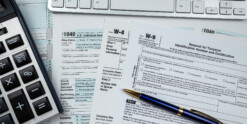As the stock market continues to reach new highs, with the Dow soaring well above 20,000, I’ve found myself reflective of other times in recent investment history. Over the years, the high and low tides — and sometimes crashing waves — of our always changing economy have taught me certain financial truths. Let me share what I learned from 1998 to 2009, a period I refer to as “The Lost Decade of Stocks.”
I moved to Atlanta just after the 1996 Olympics, a recent graduate of the University of North Carolina at Chapel Hill. In the summer of 1998, I took my first full-time position in the investment business. If you recall, Wall Street firms were enjoying a tremendous bull market run in those days.
For context, from 1981 through 1998, the Dow skyrocketed from about 1,000 to 9,000. Of course, there were blips along the way, but it averaged about 17.5 percent over the 18-year span. Homing in on the decade of the 1990s, the market was up 18.2 percent per annum. The only down years happened in 1981 (minus 4.9 percent) and 1990 when the Dow was down 3.2 percent. It was a bull market to beat all bull markets.
The year I entered the investment business, however, the landscape was about to undergo dramatic change. Let’s review some of the details of The Lost Decade of Stocks:
- In the summer of 1998, the Dow was trading at 9,000.
- Fast-forward five years, and the Dow was actually lower at 8,500, reminding us that markets can actually sink.
- By the end of the 10th year, the Dow remained lower, at 8,600 in 2008.
- It wasn’t until the 11th year, July 2009 to be precise, that markets began reaching new and sustainable highs, with the Dow getting back to its previous level of 9,000.
- As a decade, the 2000s were awful for investors: The market saw peak-to-trough drops of 49 percent and 57 percent in the years of 2000-2002 and 2007-2009, respectively. Six years were up, while four were down. In 2008, the market dropped an incredible 37 percent.
What did I learn during this period of time as an investor, and how did I weather the ebbs and flows? Sometimes there are simple answers to complex problems. I experienced the real power of optimism, patience and income.
I’ve always been optimistic about the prospects for our country and the U.S. economy. I suppose it’s just part of my nature and outlook. Often, people will ask me, “What’s the market going to do in the next few years?”
My answer? No one knows. While I have utmost confidence that our economy will continue to grow, we should always be prepared for another Lost Decade of Stocks. Plan for very modest returns, and if the ensuing economic growth matches or exceeds that of our longer term economic history, then you will create a tremendous cushion.
Perseverance through patience
Even when the market seemed to be in a free fall, I never lost faith in the power of the U.S. economic machine. Nor did I lose belief that businesses and corporate earnings would continue to grow. The Lost Decade of Stocks did, however, test my patience. Oh, did it test my patience.
What I found is that despite the weariness that may come to investors in times of economic strife, we must wait out the storm. The more patiently we wait, the vast majority of the time, the better off we are as investors.
The power of income
Turning away from emotion and toward the nuts and bolts of investing, I cannot stress enough that dividends matter. Remember, the Dow made no forward progress for 11 years — beginning at 9,000 in 1998 and roller-coastering all the way back to 9,000 by 2009. Flat. But with dividends reinvested, an investor’s total return would have been about 31 percent, or 2.5 percent per annum. Herein lies the power of dividends and income.
Of course, stocks aren’t the only asset class that pay income. There are also bonds, REITs, preferred stocks, and others that pay various levels and forms of income. But for today’s discussion, I want to focus only on stocks.
Dissecting dividends and returns, we see the income served a dual purpose of paying investors while they waited and created a decent positive return. This happened even in a long and turbulent period for stocks. To this day, I own a portfolio in which almost every investment pays something.
Income-paying viability
Your question now may be just how we determine the income-paying viability of a dividend-paying stock. First things first — the state of the economy. From what I see, we still have room to run in the current economic expansion, which allows company earnings to continue on their expansion path.
And what about on a company-to-company level? Consider these two crucial points. First, the dividend payout ratios can’t be excessive. It’s a bad sign if a company is paying out 90 percent of its earnings to meet their dividend; the income is likely soon to be cut.
Second, as long as a company has a solid record of free cash flow (a more stringent way to look at a company’s headline earnings), you’re likely in good hands. The free cash flow equation helps determine what companies are really left with at the end of any given period of time. It’s simply a company’s operating earnings minus its capital expenditures.
In the end, you want to buy companies that are growing earnings in a sustainable way as they expand. If you can find companies like this, you’ve got a great shot at continued dividend payments, or even better, increased dividends.
As we end this stroll down memory lane, I am reminded of an ancient quote from Confucius: “Study the past, if you would divine the future.” Of course, all investors know that there is no such thing as divining the next move of the stock market, but there is much wisdom here. Armed with information on how past years evolved and resolved, and learning from lessons from my personal experience, perhaps you will make practical decisions if faced with another Lost Decade of Stocks. Let’s hope we won’t have to anytime soon, but if we do, we’ll be prepared.
The original AJC article appears here.
DISCLOSURE
This information is provided to you as a resource for informational purposes only. It is being presented without consideration of the investment objectives, risk tolerance or financial circumstances of any specific investor and might not be suitable for all investors. Past performance is not indicative of future results. Investing involves risk including the possible loss of principal. This information is not intended to, and should not, form a primary basis for any investment decision that you may make. Always consult your own legal, tax or investment advisor before making any investment/tax/estate/financial planning considerations or decisions.













